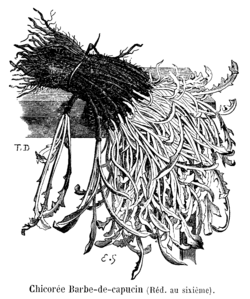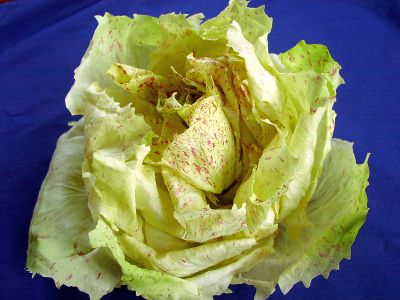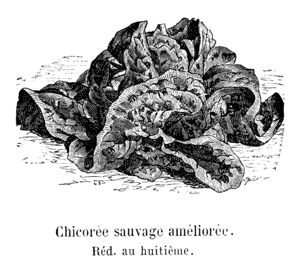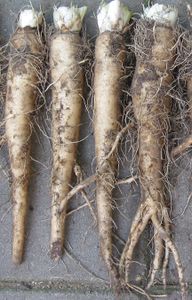Cichorium intybus
Cichorium intybus L.
| Order | Asterales |
|---|---|
| Family | Compositae |
| Genus | Cichorium |
2n =
Origin : Mediterranean area
wild and cultivated
| English | {{{english}}} |
|---|---|
| French | {{{french}}} |
Description
Popular names
| English | chicory |
| French | chicorée amère |
Classification
Cultivars
No complete system of botanical classification has ever been published, many cultivar groups having remained unknown to botanists. Some authors use to distinguish cultivars with big root and cultivars with a slender root. We follow here a pragmatic classification based on uses.
Cutting chicory Group
- English: cutting chicory
- French: chicorée à couper
- German: Schnittzichorie
- Spanish: achicoria de cortar
- Italian: cicoria da taglio, cicoria spadona
This type is well known in Italy. Leaves can be cut several times. At leat one type, 'Barbe de capucin' (Italian: barba di cappuccino; German: Kapuzinerbart) is grown like Witloof, roots being forced in caves and bleached leaves eaten as a delicacy.
Sugarloaf Group
- English: Sugarloaf
- French: chicorée Pain-de-Sucre
- German: Zuckerhut
- Dutch: groenlof
- Spanish: achicoria Pan de Azúcar
- Italian: cicoria Pan di Zucchero
Known above all in Italy, france and Switzerland as a winter salad. ‘Bianca di Milano’ is a similar cultivar.
Catalogna Group
In spite of their name, this group is mostly known from Italy and Greece. In Italy, a subtype is grown for its thick stems, about ten arising from the base. When collected at an early stage, it is called mazzocchi. Later it becomes puntarelle.
When cut in longitudinal slices and put in water, the slices curl. They are eaten raw, simply accomodated with a sauce of crushed anchovies and olive oil. Those puntarelle alla salsa d'alici are one of the most intriguing and marvelous Italian salads.
Radicchio Group
- English: red-leaved chicory
- French: chicorée italienne, chicorée rouge
- German: Radicchio
- Dutch: rodlof
- Italian: radicchio
This group arose in the North-East of Italy. They are either collected in winter form the fields, or forced in caves.
Grumolo Group
This type forms a small rosette of rounded leaves. It is an excellent winter salad, for example with mimosa eggs.
Witloof Group
- English: chicory, Brussel chicory, witloof chicory
- French: endive, chicorée witloof ; chicon (Belgium)
- German: Chicorée
- Dutch: witlof
- Spanish: endive, endibia, achicoria de Bruselas
- Italian: cicoria belga, cicoria di Bruxelles, cicoria witloof
This type arose recently, about 1850 near Brussels. It has become a major industrial product. It is grown in tow stages. The plant is sown in fields, and roots are collected in autumn and stored during winter times. They are put to forcing according to market. Leaves form a thick oblong head. First cultivars could form their head only if covered by earth. New cultivars developed in the 1970's can form their head without earth, which allowed production to be done hydroponically in stacked trays.
Witloof is the Flemish name, meaning "white foliage". The Dutch prefer the form witlof. It has become the standard technical name. In Belgium and northern France, the product is called chicon, whereas in most of France, it has taken the name endive.
Industrial Chicory Group
- English: succory
- French: chicorée à café, chicorée à sucre
- German: Wurzelzichorie, Zichorienwurzel, Kaffeezichorie
- Dutch: cichoreiwortel
- Spanish: achicoria de raiz
- Portuguese: chicória do café
- Italian: cicoria a radice
A specialty of northern France and Belgium, it is an industrial crop, mostly grown as a substitute of coffee, being caffeine-free. Part of the production is now the source of inuline.
Soncino Group
- Italian: radice di Soncino
An endemic vegetable of Liguria (Italy).
see Vilmorin-Andrieux's article.
History
- see Candolle's article.
- see Sturtevant's article.












